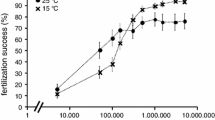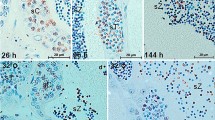Abstract
Spermatophore successive manual extrusions are often employed in hatcheries, but it causes melanin deposition, decreasing sperm quality via cell degeneration. Melanization (brown or black spots) is an indicator of the moment to discard males. The evaluation of more efficient strategies is required to avoid it, increasing males’ lifespan. The effects of two temperatures (26 and 30 °C) on closed thelycum Farfantepenaeus paulensis spermatophore melanization and sperm quality after successive manual extrusions were evaluated. Wild-caught males were acclimated to laboratory conditions for 1 week and fed commercial broodstock feed and fresh-frozen food items ad libitum four times a day. Later, a 35-day trial was conducted with 24 males (26.05 ± 2.4 g) randomly distributed into eight 200-L tanks (4.3 shrimps m−2). Temperature was gradually increased from 23 to 26 °C or 30 °C. Only males showing a formed spermatophore and in the intermolt period were submitted to four consecutive manual extrusions every 11 days. Melanization was visually examined in extruded spermatophores, which were weighed. Spermatozoa were released in saline solution and observed in a hemacytometer under a light microscope. Morphological abnormalities (main body or spike malformations) were identified. Total and abnormal spermatozoa were counted in five fields of the hemacytometer to calculate sperm count and abnormal sperm rate. No significant differences were found on sperm quality among extrusions, but from the second extrusion onwards, an increase of melanization was evident. On the other hand, temperature did not affect the occurrence of spermatophore melanization related to successive extrusions.
Similar content being viewed by others
References
Alfaro J (1993) Reproductive quality evaluation of male Penaeus stylirostris from a growout pond. J World Aquacult Soc 24:6–11
Alfaro-Montoya J (2010) The reproductive conditions of males shrimps, genus Penaeus, sub-genus Litopenaeus (open thelyca penaeoid shrimp): a review. Aquaculture 300:1–9
Braga A, Nakayama C, Poersch L, Wasielesky W (2013) Unistellate spermatozoa of decapods: comparative evaluation and evolution of the morphology. Zoomorphology 132:261–284
Braga A, Lopes D, Poersch LH, Wasielesky W (2014a) Spermatophore replacement of pink shrimp Farfantepenaeus brasiliensis after manual extrusion: effect of molting. Aquaculture 433:313–317
Braga A, Suita de Castro LA, Poersch LH, Wasielesky W (2014b) Spermatozoal capacitation of pink shrimp Farfantepenaeus paulensis. Aquaculture 430:207–210
Braga A, Lopes D, Magalhães V, Klosterhoff M, Romano LA, Poersch LH, Wasielesky W (2018a) Hemocytic melanization in shrimp spermatophores. Aquaculture 486:64–67
Braga A, Lopes D, Magalhães V, Klosterhoff M, Romano LA, Poersch LH, Wasielesky W (2018b) Infertility of biofloc-reared Litopenaeus vannamei males associated with a spermatophore mycobacterial infection: description of the pathological condition and implications for the broodstock management and larval production. Aquaculture 492:357–360
Bray WA, Lawrence AL (1992) Reproduction of Penaeus species in captivity. In: Fast A, Lester LJ (eds) Marine shrimp culture: principles and practices. Elsevier Science Publishers B.V, The Netherlands, pp 93–169
Cavalli RO, Scardua MP, Wasielesky W (1997) Reproductive performance of different-sized wild and pond-reared Penaeus paulensis females. J World Aquacult Soc 28(3):260–267
Ceballos-Vázquez BP, Aparicio-Simón B, Palacios E, Racotta IS (2004) Sperm quality over consecutive spermatophore regeneration in the Pacific white shrimp Litopenaeus vannamei. J World Aquacult Soc 35(2):178–188
Chamberlain G, Johnson GX, Lewis DL (1983) Swelling and melanization of the male reproductive system of captive adult penaeid shrimp. J World Maricult Soc 14:135–136
Clark WH, Lynn JW, Yudin AI, Persyn HO (1980) Morphology of the cortical reaction in the eggs of Penaeus aztecus. Biol Bull 158:175–186
Diamond S, Powell A, Shields RJ, Rowley AF (2008) Is spermatophore melanization in captive shrimp (Litopenaeus vannamei) a result of an auto-immune response? Aquaculture 285:14–18
Díaz AC, Gimenez AVF, Harán NS, Fenucci JL (2001) Reproductive performance of male argentine red shrimp Pleoticus muelleri Bate (Decapoda, Penaeoidea) in culture conditions. J World Aquacult Soc 32:236–242
Dougherty WJ, Dougherty MM (1989) Electron microscopical and histochemical observations on melanized sperm and spermatophores of pond-cultured shrimp, Penaeus vannamei. J Invertebr Pathol 54:331–343
Leung-Trujillo JR, Lawrence AL (1987) Observations on the decline in sperm quality of Penaeus setiferus under laboratory conditions. Aquaculture 65:363–370
Leung-Trujillo JR, Lawrence AL (1991) Spermatophore generation times in Penaeus setiferus, P. vannamei, and P. stylirostris. J World Aquacult Soc 22(4):244–251
Marchiori MA, Boff MH (1983) Induced maturation, spawning and larvae culture of the pink shrimp Penaeus paulensis Pérez-Farfante, 1967. Mem Asoc Latinoam Acuicult 5:331–337
Nakayama CL, Peixoto S, Lopes D, Vita G, Krummenauer D, Foes G, Cavalli RO, Wasielesky W (2008) Métodos de extrusão manual e elétrica dos espermatóforos de reprodutores selvagens do camarão-rosa Farfantepenaeus paulensis (Decapoda: Penaeidae). Ciênc Rural 38(7):2018–2022
Nappi AJ, Vass E (1993) Melanogenesis and the generation of cytotoxic molecules during insect cellular immune reactions. Pigment Cell Res 6:117–126
Palacios E, Perez-Rostro CI, Ramirez JL, Ibarra AM, Racotta IS (1999) Reproductive exhaustion in shrimp (Penaeus vannamei) reflected in larval biochemical composition, survival and growth. Aquaculture 171:309–321
Parnes S, Raviv S, Shechter A, Sagi A (2006) Males also have their time of the month! Cyclic disposal of old spermatophores, timed by the molt cycle, in a marine shrimp. J Exp Biol 209:4974–4983
Pascual C, Valera E, Re-Regis C, Gaxiola G, Sanchez A, Ramos L, Soto LA, Rosas C (1998) Effect of temperature on reproductive tract condition of Penaeus setiferus adult males. J World Aquacult Soc 29:477–484
Peixoto S, Cavalli RO, Wasielesky W, D'Incao F, Krummenauer D, Milach AM (2004) Effects of age and size on reproductive performance of captive Farfantepenaeus paulensis broodstock. Aquaculture 238:173–182
Peixoto S, Wasielesky W, Cavalli R (2011) Broodstock maturation and reproduction of the indigenous pink shrimp Farfantepenaeus paulensis in Brazil: an updated review on research and development. Aquaculture 315:9–15
Pratoomchat B, Piyatiratitivorakul S, Menasveta P (1993) Sperm quality of pond-reared and wild-caught Penaeus monodon in Thailand. J World Aquacult Soc 24:530–540
Sánchez A, Pascual C, Sánchez A, Vargas-Albores F, Moullac GL, Rosas C (2001) Hemolymph metabolic variables and immune response in Litopenaeus setiferus adult males: the effect of acclimation. Aquaculture 198:13–28
Sarathi M, Ahmed VPI, Venkatesan C, Balasubramanian G, Prabavathy J, Hameed ASS (2007) Comparative study on immune response of Fenneropenaeus indicus to Vibrio alginolyticus and white spot syndrome virus. Aquaculture 271:8–20
Wang Q, Misamore M, Jiang CQ, Browdy CL (1995) Egg water induced reaction and biostain assay of sperm from marine shrimp Penaeus vannamei: dietary effects on sperm quality. J World Aquacult Soc 26:261–271
Funding
R.O. Cavalli and W. Wasielesky are research fellows of Conselho Nacional de Desenvolvimento Científico e Tecnológico–CNPq (Procs. 307528/2017-0 and 310652/2017-0, respectively).
Author information
Authors and Affiliations
Corresponding author
Ethics declarations
Conflict of interest
The authors declare that they have no conflict of interest.
Research involving animals
All specimens used in this study were captured by commercial fisheries in accordance with regulation no. 11959/2009 of the Instituto Brasileiro do Meio Ambiente e dos Recursos Naturais Renováveis of the Ministério do Meio Ambiente (IBAMA–MMA). The experiment and collection of biological samples were conducted in accordance with relevant institutional and national ethical guidelines (regulation nos. 11794/2008 and 6899/2009).
Additional information
Publisher’s note
Springer Nature remains neutral with regard to jurisdictional claims in published maps and institutional affiliations.
Rights and permissions
About this article
Cite this article
Nakayama, C.L., Lopes, D., Braga, A. et al. Does temperature affect the occurrence of penaeid spermatophore melanization related to successive manual extrusions? A case study with the closed thelycum Farfantepenaeus paulensis. Aquacult Int 28, 1657–1663 (2020). https://doi.org/10.1007/s10499-020-00549-6
Received:
Accepted:
Published:
Issue Date:
DOI: https://doi.org/10.1007/s10499-020-00549-6




